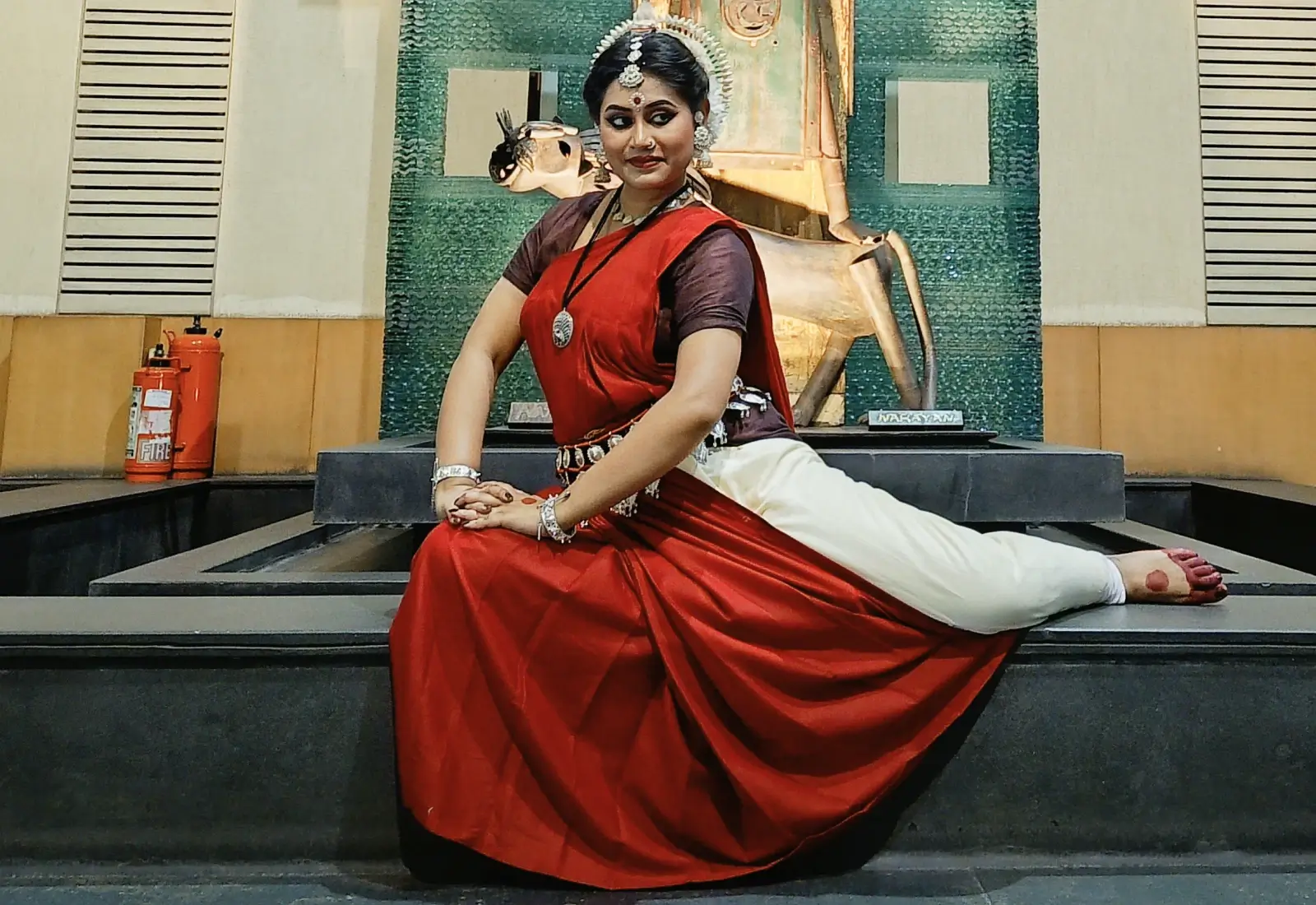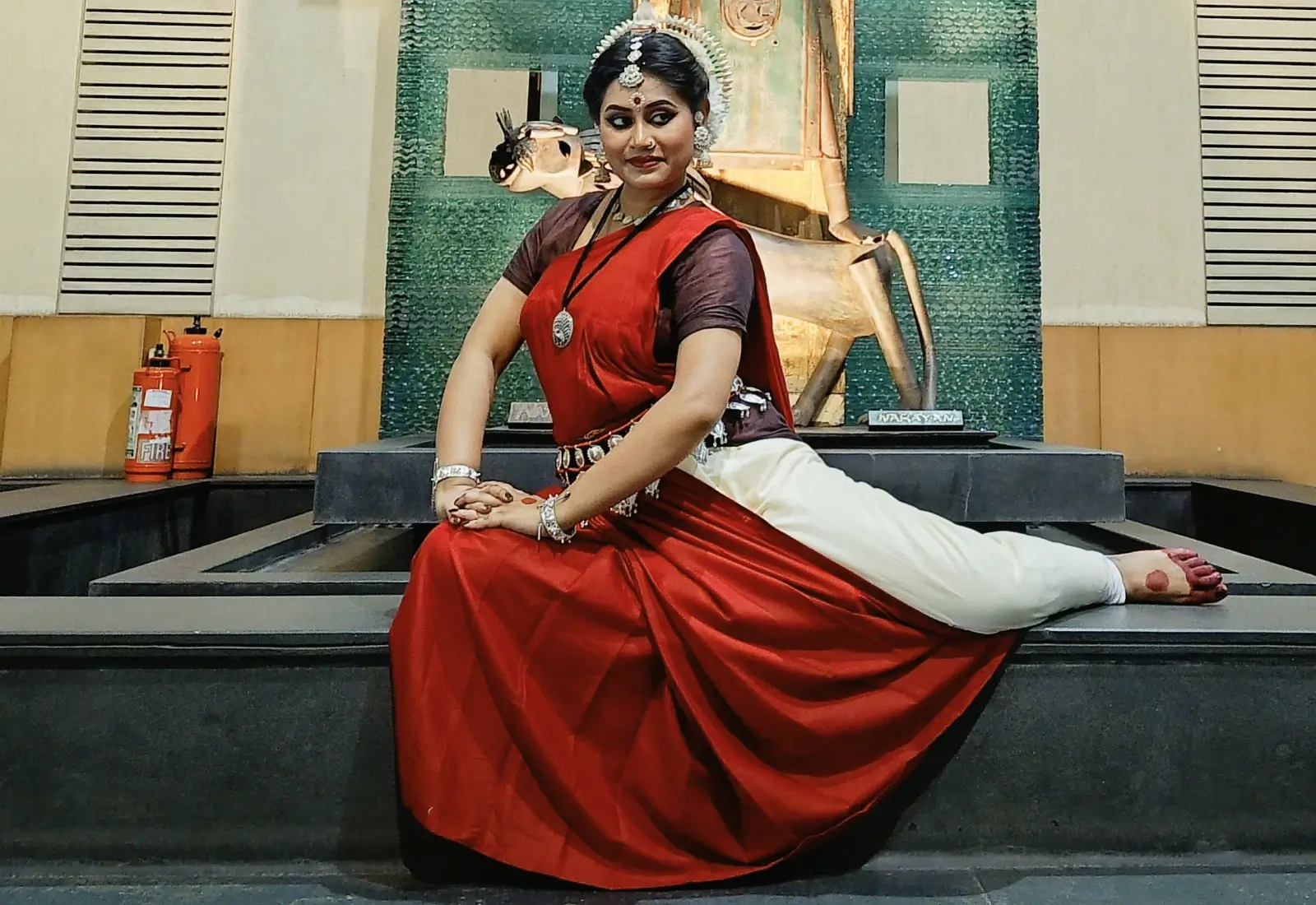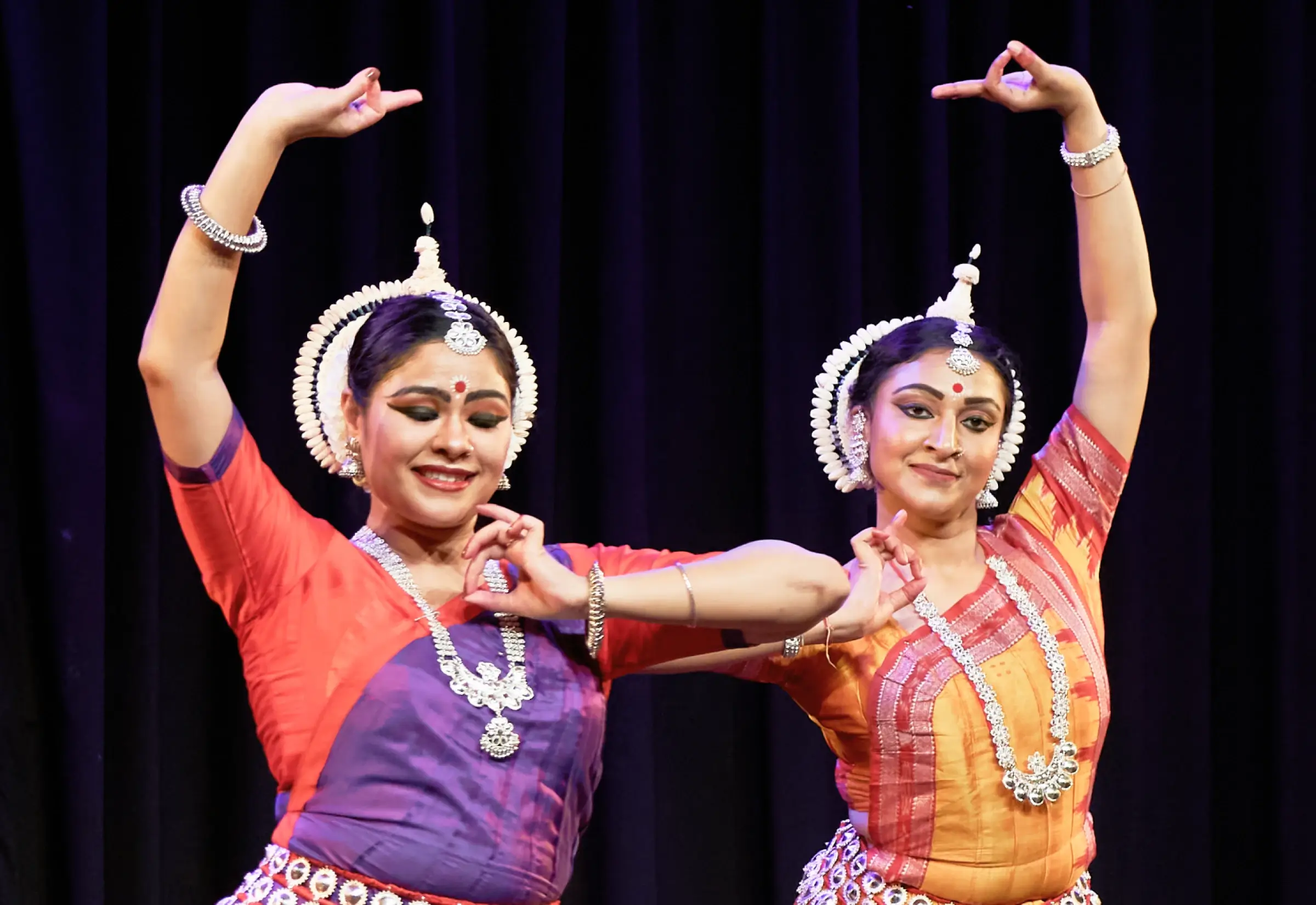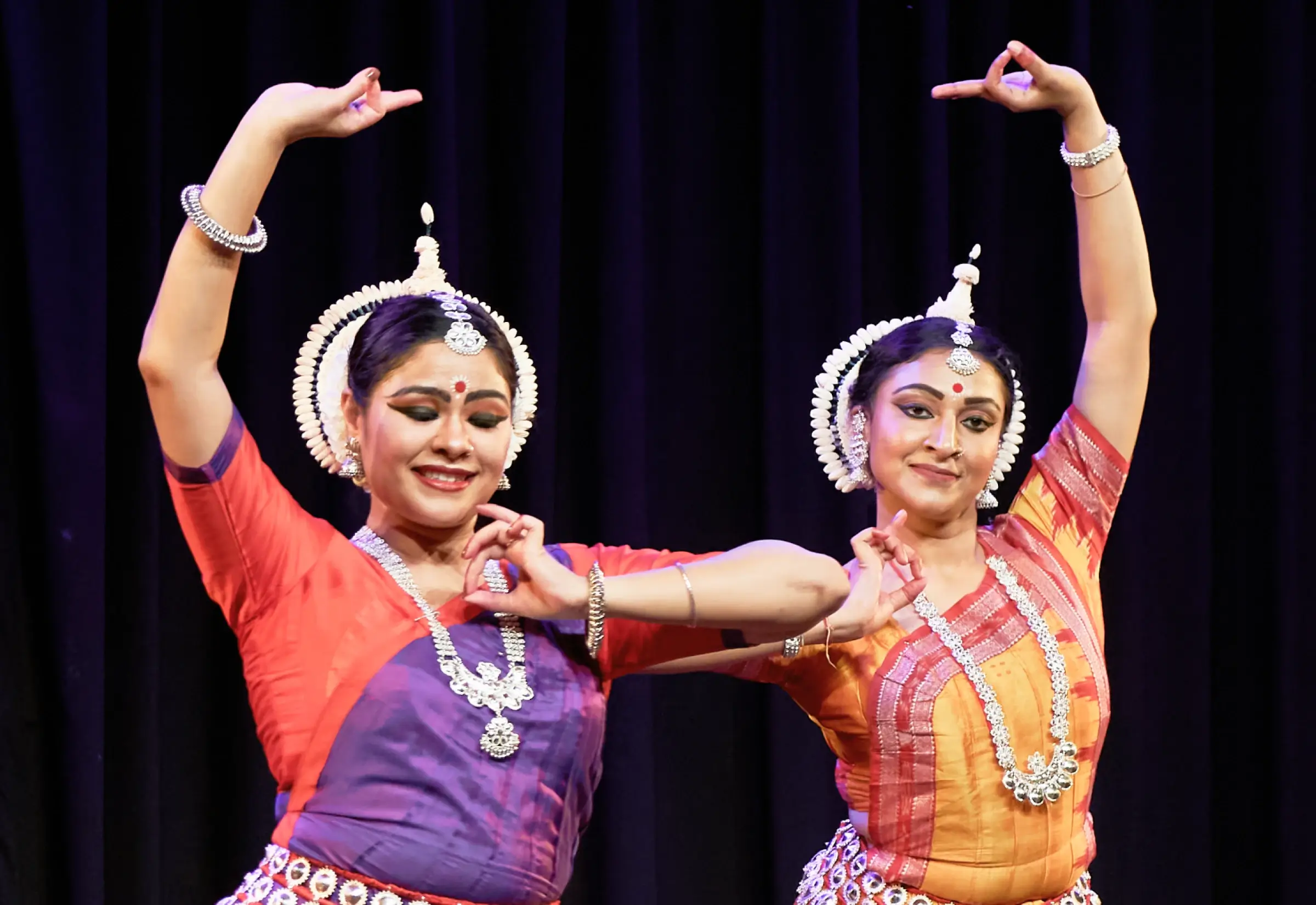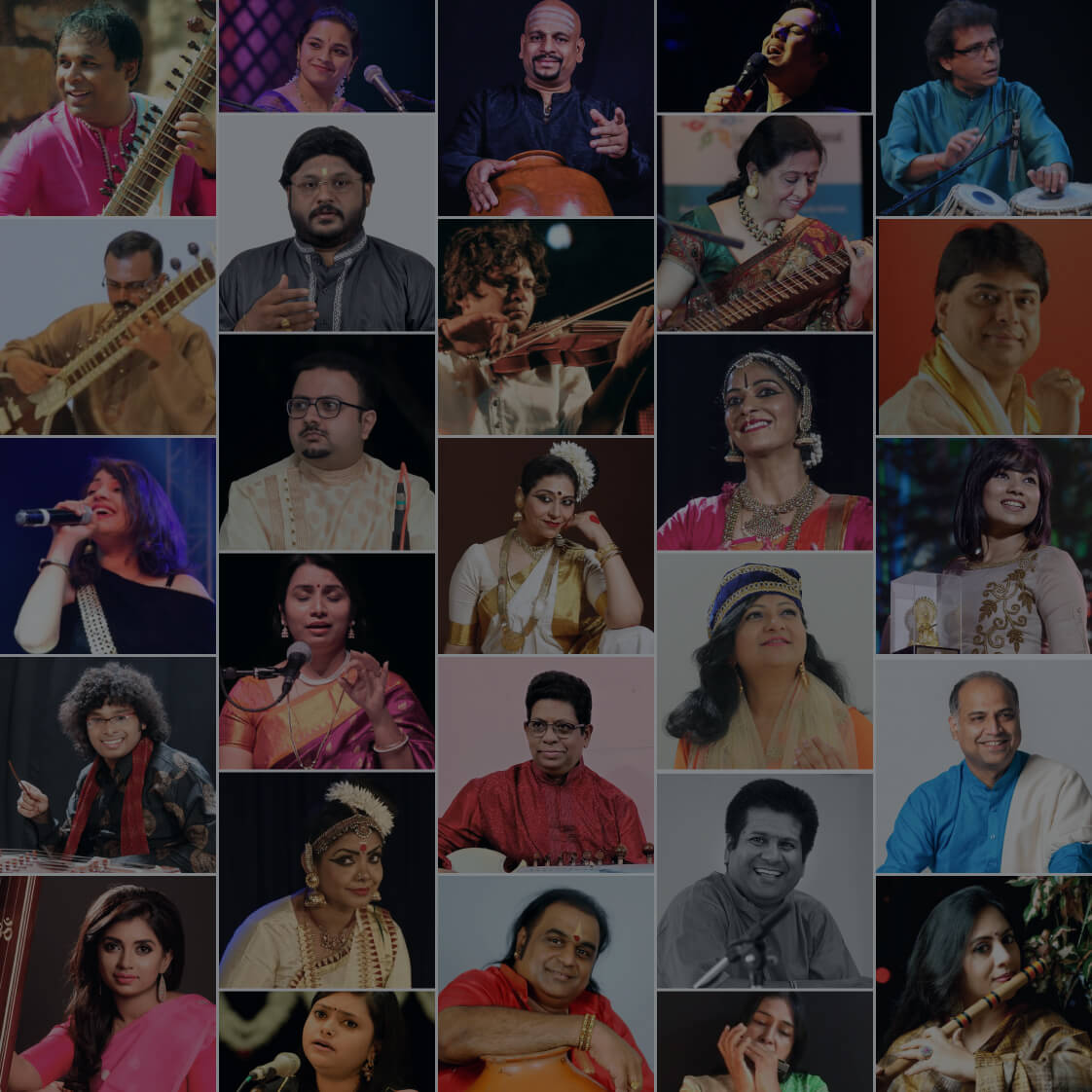8 Odissi Dance Poses
The ecstasy of the divine union between Radha and Krishna as it is captured in the verses of Geetagovindam is believed to be the most favored hymn of Lord Jagannath. The legends have it that the Lord loved to hear the verses and watch them being enacted repeatedly through day and night without getting tired of it. This necessitated the birth of the overtly graceful, intense, and sensuous - Odissi dance.
The Odissi dance form was meant to appease the divinity. Hence the appeal of every posture and dance move comes with a pull that is hard to evade from. Here is an attempt to decipher Odissi dance posture and movements through the basic steps and structure of an Odissi dance repertoire.
Here are 8 Odissi Dance Postures
1. Chauka/Chowk
2. Tribhanga
3. Abhanga
4. Mangalcharan
5. Sthai
6. Pallavi
7. Abhinaya
8. Moksha
1. Chauka/Chowk
Chauka is a fundamental posture in Odissi dance. It represents the masculine aspects of strength and stability. As in the Odiya folklore, it is believed to stand for Lord Jagannath, the bestower of stability in the universe.
Chauka or Chowk is attained by half squatting with your feet a little more than shoulder length apart. Your knees are bent. Toes pointing inwards and feet pointing outwards. The knees are aligned over the feet, forming a square shape, which is why it's called "Chauka" (meaning "square" in Odia). Your torso is straight and your hands are spread out. Arms are kept parallel to the ground, bent from the elbow with hands positioned frontwards in Pataka or Tripataka Mudra.
Practicing Chauka helps dancers build strong leg muscles and maintain balance. It is essential for performing the intricate footwork and poses characteristic of Odissi dance.
2. Tribhanga
The word "tribhanga" means "three bends." The body bends at the neck, torso, and hips. Tribhanga is a unique pose in Odissi dance. This posture gives the dance form its identity.
This is the pose in which Lord Krishna plays the flute - earning Him the name - Tribhanga Murari. One leg is straight, while the other crosses it, and the upper body bends in the opposite direction. The head tilts the same way as the hip.
This pose adds grace and sensuousness to the dance. This pose brings out feminine qualities like softness, allure, and love.
In the basic Tribhanga posture, the weight shifts to one hip, the torso bends in the opposite direction, the head tilts, one hand rests on the hip, and the other on the leg.
Tribhang is a very feminine pose, seen in many sculptures. The bends are at the knees, torso, and neck. This movement, along with the shifting of the upper body, makes Odissi dance challenging to perform.
3. Abhanga
The Abhanga pose in Odissi dance features a slight deflection or bend in the body, creating an asymmetrical line. In this pose, the dancer's weight is shifted onto one leg, while the other leg is relaxed and slightly bent at the knee. This creates a gentle S-shaped curve in the body. The hips tilted to one side, and the torso and head lean in the opposite direction. It creates a balanced but dynamic stance.
There is a semblance of strength and elegance in this pose. It is less rigid than the Chauka but still maintains a controlled posture. The arm positioning enhances the overall flow of the pose. One arm extended outward and the other placed on the hip or in a decorative mudra.
This pose is often used to depict feminine beauty and delicacy. It is a common choice in lyrical and expressive parts of the dance. It is a foundational posture in Odissi that emphasizes fluidity and sculpture-like poses. Practicing Abhanga helps dancers develop their balance, control, and expressiveness.
4. Mangalcharan
The Odissi dance repertoire is divided into 5 parts. They are Mangalcharan, Sthayi, Pallavi, Abhinaya, and Moksha.
Mangalcharan is the first part of an Odissi dance performance.
The word "Mangalcharan" originates from Sanskrit. It is a compound word made of two parts: "Mangal" and "Charan." Mangal means "auspicious" or "blessed." It signifies something that brings good fortune or positive energy. And Charan means "feet" or "steps." In a broader sense, it can also mean "act" or "ritual."
Together, "Mangalcharan" means an auspicious act or ritual performed at the beginning of an event. Mangalcharan refers to the initial invocation or prayer that sets a positive and sacred tone for the performance. This ritual involves saluting the deities, the teacher (guru), and the audience. It makes sure that the dance begins with blessings and reverence. This part sets a spiritual tone for the performance.
Mangalcharan is again divided into several parts -
Mancha Pravesh
The dancer makes a ceremonial entrance onto the stage, often accompanied by live music. The entrance is graceful and measured, showcasing the dancer's poise and command over the stage.
Bhumi Pranam or Salutation to Mother Earth
The dancer starts by paying respect to the earth, symbolizing gratitude and humility. This involves kneeling and touching the ground, then bringing the hands to the forehead and chest.
Trikhandi Pranam
This is a three-fold salutation directed towards the gods, the guru (teacher), and the audience. It signifies respect and seeks blessings for a successful performance.
Vandana (Invocation to the Deities)
The dancer invokes the blessings of the Hindu deities through specific gestures (mudras) and movements. Vandanas in Odissi dance often includes a prayer or hymn dedicated to a particular deity, such as Lord Jagannath, Ganesha, or Saraswati.
Pushpanjali (Offering of Flowers)
The dancer offers imaginary flowers to the gods, symbolizing devotion and purity. This act of offering is performed with elegant hand movements and a serene expression.
Also read - Odissi Dance: Origin, History & Famous Dancers on ipassio wiki
5. Sthai
As the performance proceeds ahead, after Mangalcharan comes Batu or Sthai. It falls under the category of Nritta, which means pure dance. This part of the dance focuses on abstract movements without any storytelling. It establishes the fundamental physical grammar of Odissi. It draws inspiration from ancient sculptures and the movements of Gotipua dancers.
Various postures (bhangis), movements (belis), and short dance sequences (arasas) feature in sthai. Rhythmic patterns called ukutas and repeated musical refrains go with these dance sequences. The emphasis is on precision and grace. It highlights the dancer's skill and the beauty of Odissi's intricate techniques. This pure dance form is essential for building a dancer's technical foundation. It showcases the rich visual language of Odissi dance.
6. Pallavi
Pallavi in Odissi dance is a lyrical and graceful piece. It showcases the dancer's skill and artistry. The word "Pallavi" means "blossoming" in Sanskrit. This dance piece features a gradual unfolding and expansion of a melody or rhythm. It starts slowly and builds up in complexity and speed, much like a flower blooming.
Pallavi plays a significant role in the Odissi dance sequence. It serves as a showcase for the dancer's technical prowess and creativity. It is a pure dance form, meaning it focuses on the beauty of movement rather than storytelling or expressing emotions. This allows the audience to appreciate the dancer's technique and the aesthetic qualities of the dance. Pallavi also provides a moment of lightness and joy in the performance, offering a visual delight with its rhythmic and melodic variations.
The choreography involves intricate footwork, elegant body movements, and expressive hand gestures. It is set to a particular raga (melodic framework) and tala (rhythmic cycle). The dance sequence often begins with simple steps and gradually incorporates more elaborate patterns. The movements are synchronized with the musical composition, highlighting the interplay between dance and music. The dance moves include spins, jumps, and various postures that demonstrate control and precision.
7. Abhinaya (Expressions)
Abhinaya in Odissi dance is the expressive aspect where the dancer conveys emotions and tells stories through gestures, facial expressions, and body movements. The word "Abhinaya" means "to carry forward" or "to convey," and in this context, it involves the dancer portraying various characters, emotions, and narratives from mythological stories and classical literature.
Abhinaya is an important feature of Odissi dance. It adds depth and meaning to the performance, allowing the audience to connect emotionally with the stories being told. This expressive component contrasts with the pure dance elements like Pallavi, providing a balance between technical skill and emotional depth. Abhinaya enriches the overall performance, making it not just a visual spectacle but also an emotional and spiritual experience for the audience.
The choreography of Abhinaya involves detailed planning and practice. It includes specific hand gestures (mudras), facial expressions (bhavas), and body movements (angas). The dancer uses these elements to depict the emotions and actions of the characters in the story. Each gesture and expression is carefully chosen to convey a particular meaning, making the performance engaging and expressive. The music and lyrics play a crucial role in guiding the dancer’s expressions and movements, ensuring that the narrative is clear and compelling.
In Odissi dance, dancers interpret Sanskrit and Odia texts through their movements. These texts include the Gitagovinda and poetry from Odia Bhakti poets like Upendra Bhanja, Banamali Das, and Baladev Rath from the 16th to 18th centuries.
8. Moksha
Moksha in Odissi dance represents the final stage of the performance, symbolizing liberation and spiritual freedom. The word "Moksha" means "release" or "liberation" in Sanskrit. In this dance, it signifies the soul's release from the cycle of life and death, achieving a state of bliss and peace.
The choreography of Moksha is designed to evoke a sense of transcendence and joy. It typically features fast-paced and dynamic movements, highlighting the dancer's technical prowess and energy. The dance begins with slow, graceful movements and gradually builds up to a climax with rapid, intricate footwork and expressive gestures. The music accompanying Moksha is usually uplifting and rhythmic, enhancing the overall feeling of liberation.
Moksha plays a vital role in the Odissi dance sequence. It serves as the concluding piece, bringing the performance to a powerful and uplifting end. This segment allows the dancer to showcase their mastery over the dance form, leaving the audience with a sense of awe and fulfillment. Moksha encapsulates the spiritual essence of Odissi, reminding both the dancer and the audience of the ultimate goal of inner peace and liberation.
As We Conclude…
Odissi as a dance form has survived the test of time and emerged as an emblem of India’s culture and heritage. With contributions from revered dancers such as Pankaj Charan Das, Kelucharan Mohapatra, and many more this dance form has etched a unique place in the ambit of Indian classical dance. Many dance enthusiasts aspire to become Odissi dancers. If you are one of them, you could explore opportunities to learn Odissi online.


